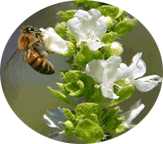Nutrients in Garlic and it’s health benefits
© Copyright Bee Wilder
Garlic (Allium sativum) is a member of the Lily family, which contains over 6,000 species including well-known edible plants such as onion, chives, leek, and shallot.
The ancient Egyptians, Greeks, Chinese,
Indians and Romans all advocated the therapeutic value of garlic in the
treatment of ailments ranging from eye disorders, sore throats and headaches to
old age. It was even know as an aphrodisiac.
More recently, garlic was used in the
First and Second World War both as an oral medicine to treat battleground
infections and as a wound dressing. It was a great success in both
applications.
Modern medicine is now investigating
garlic’s traditional properties and, surprisingly, several of them are standing
up to scientific scrutiny. Clinical ecologists are particularly interested in
it as an antifungal, detoxifier and immune-system regulator.
Garlic is also very effective in treating
lung disorders, i.e. coughs, bronchitis, pneumonia, etc., by drinking 4 to 5 cups of garlic tea per day.
Antibiotic Activity
Louis Pasteur commented on the bactericidal (bacteria – killing) effect of
fresh garlic juice when dropped onto growing bacterial colonies. Over the years
studies have shown that fresh garlic juice inhibits the growth of Staphylococcus
(wound infection), Brucella (brucellosis), Salmonella
(Typhoid) and several other bacteria. The action was comparable in vitro (in
the laboratory) with that of several antibiotics including penicillin, streptomycin, chloramphenicol,
tetracycline and erythromycin.
Antifungal Activity
The action of garlic on yeast and fungi is perhaps even more dramatic. One
study showed that growth of all soil fungi was totally inhibited by an
aqueous garlic extract. Medically-important fungi and yeasts (notably
Candida albicans are also
inhibited and then killed by increasing concentrations.
This is particularly useful, since the range of antifungal agents available to
the practitioner is far smaller than the range of antibacterial agents,
resulting in fewer alternative treatment regimes if complications occur.
Garlic, of course, has far less risk of side-effects than most antifungals and
can be used indefinitely in quite large amounts (the patient’s nearest and
dearest permitting!).
To treat babies or small children with
garlic, rub raw crushed garlic into their feet.
Immune Modulator
New scientific data shows that garlic can be a
potent immune-regulator. Researcher used mice
implanted with transitional carcinoma (cancer) and introduced garlic extract
both systemically (into the whole body) and into the actual tumors. They found
that the tumors were reused and/or eliminated and that the degree of
beneficial effect corresponded with the dosage level and length of garlic
treatment.
In humans, garlic has been shown to enhance the activity of natural killer (NK)
cells. These are cells that act as part of the immune defense
system and can destroy some types of tumor cells.
Detoxification and Antioxidant Activities
Garlic contains significant amounts of vitamins A, C, B1, iron, copper, zinc,
calcium and sulphur. It is a rich source of organically-bound selenium and
germanium. Nutritionally, selenium is known to aid in detoxifying heavy metals
and this may explain why garlic has been shown to be effective in countering
lead, mercury, cadmium and arsenic poisoning.
There is a growing awareness of the damaging contribution that free radicals
make to many degenerative conditions including cancer and ageing (see anti-oxidants).
Garlic has been shown to have a free-radical scavenging activity, probably
because of the oxidation potential of many of the free sulphur compounds in
garlic and also from the selenium, zinc and glutathione found in garlic and
known to enhance the concentration of certain antioxidant enzymes super oxide dismutase and gluta-thione peroxidase.
Garlic’s antibacterial and antifungal activities come
from allicin and ajoene respectively. Allicin is also
responsible for the characteristic odor of garlic.
Raw Garlic versus Garlic Supplements
The very best form of garlic is raw and crushed,
preferably certified organic. Be cautious about buying regular commercial
garlic since some may be irradiated. When
raw garlic is crushed it starts a chemical process which creates allicin and ajoene.
Crush raw garlic with the blade of a broad
knife, or put it through a garlic press.
There are a variety of garlic supplements
currently available from health food shops and chemists. Most of them are
‘garlic pearls’ which contain various amounts of garlic oil. There are also garlic
tablets that contain dried powered garlic.
Commercial garlic oil contains little allicin and ajoene,
due to the heat extraction process: thus a great deal of the antimicrobial
function is lost.
Homemade Garlic Oil
You can easily make your own garlic oil by crushing up and mincing enough garlic cloves to fill 1/4 cup. Put 1 cup of extra virgin olive oil or coconut oil in a jar with a tight fitting lid. Add the 1/4 cup of minced garlic. Keep at room temperature for 14 days, preferably in direct sunlight, and shake it once every day.
Garlic powders and tablets offer greater
reliability in ensuring that at least some of the antimicrobial substances are
still present. However these products can be very variable and some are useless. The
best powders are those where freshly chopped or pureed garlic is used and has not been
heated or dried for long periods, thus preserving the antimicrobial components.
Best of all are freeze-dried preparations like Kyolic.
Garlic Tea
Another very
effective way to get the benefits of raw garlic is by drinking garlic tea:
- Boil 4 cups of filtered water, and remove it from the heat.
- Add 4-5 large crushed cloves of garlic.
- Add the juice of one lemon, freshly squeezed.
- Drink 4 cups throughout the course of a day. It is good hot or cold. It may be reheated, but do not bring it to a boil.
